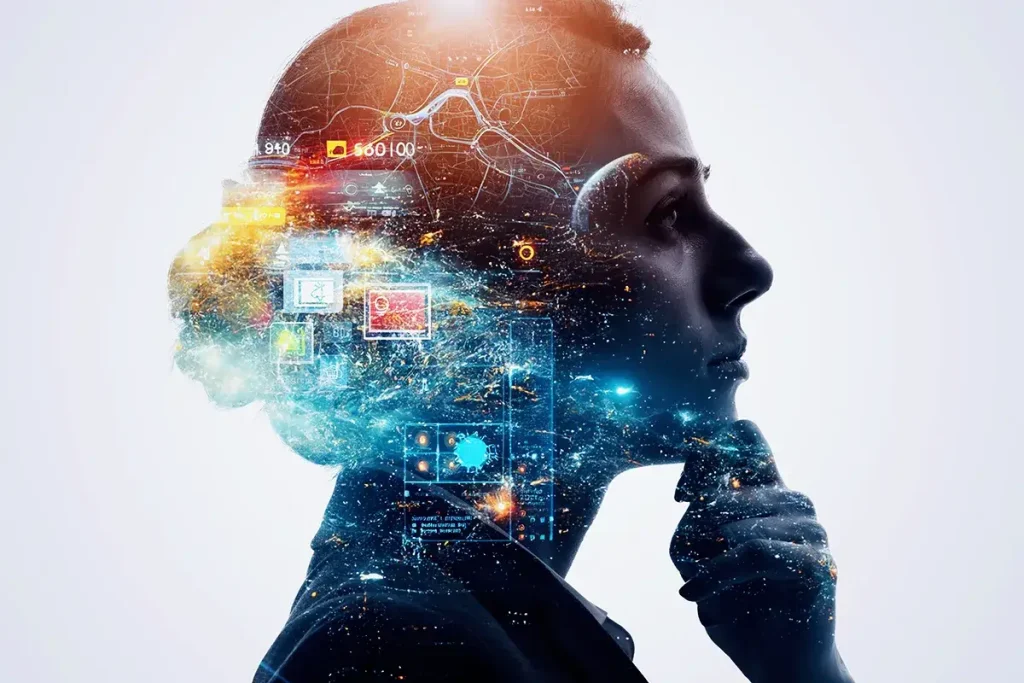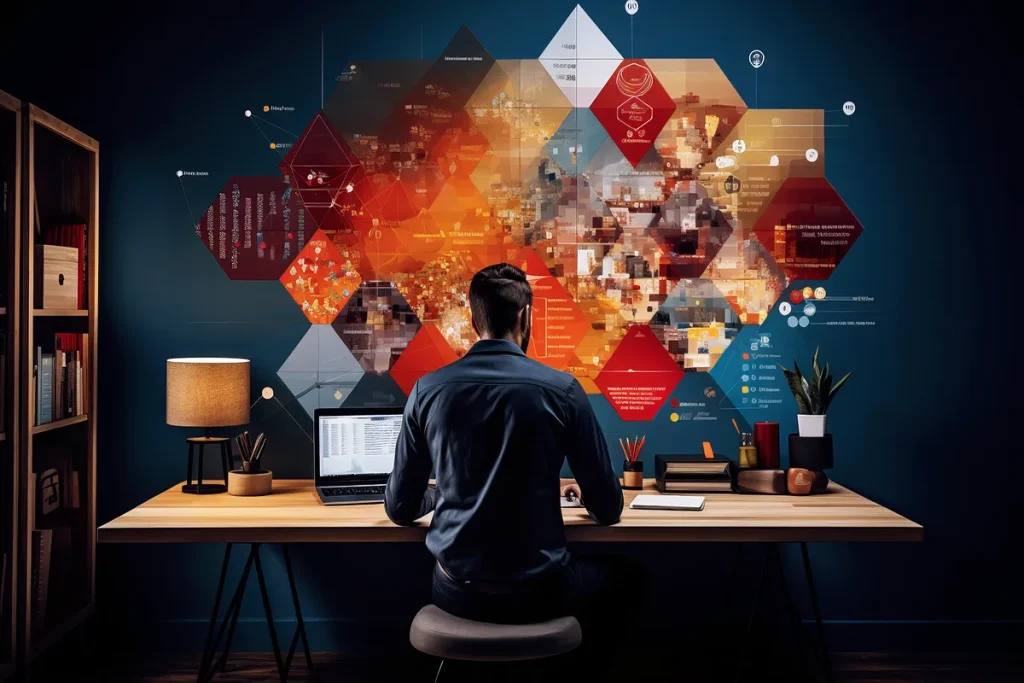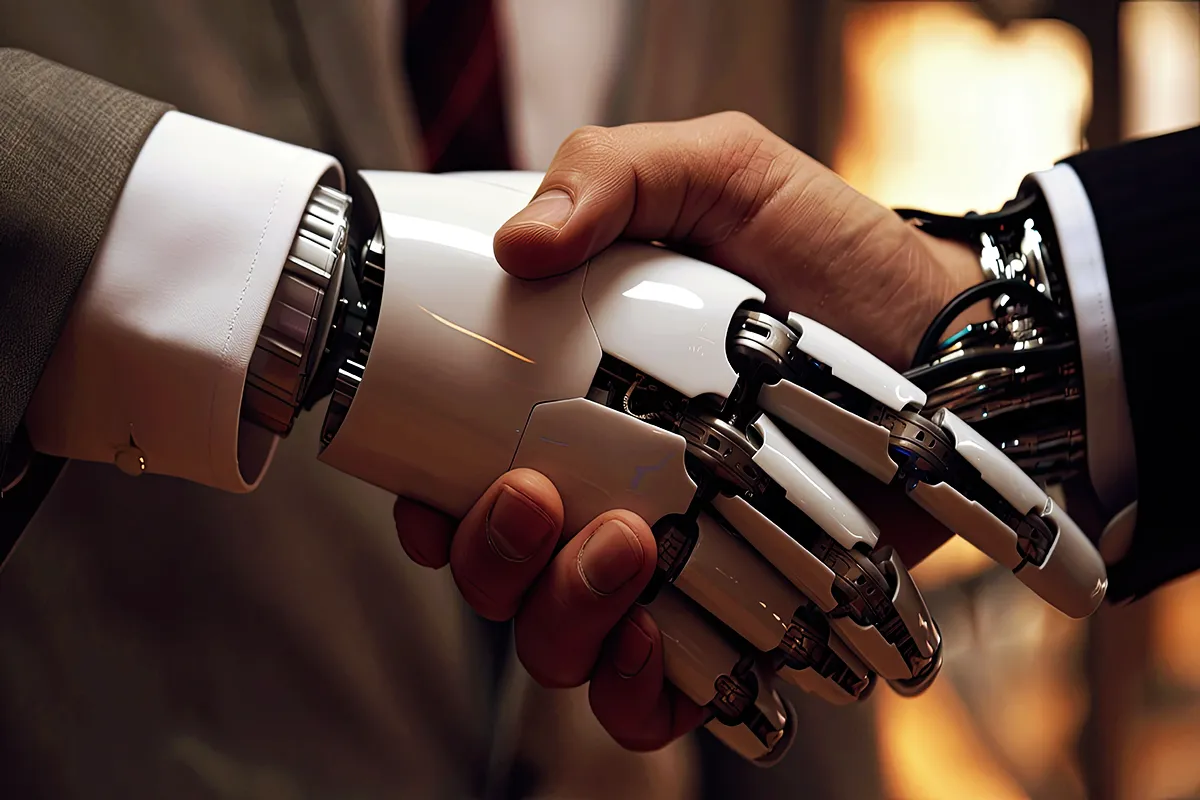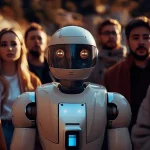You walk into your office on a Monday morning, coffee in hand, ready to tackle the week ahead. But as you sit down at your desk, you realize your most productive colleague isn’t human at all – it’s an AI. This isn’t science fiction; it’s the reality of today’s workplace. AI coworkers are here, and they’re changing everything we thought we knew about work. They don’t take coffee breaks, they don’t gossip by the water cooler, and they certainly don’t call in sick. But they’re also not just glorified calculators or virtual assistants. These AI entities are reshaping our professional landscape in ways we never saw coming. So, let’s dive into this brave new world of human-machine collaboration and uncover the hidden impacts that are transforming our work lives.
Overview:
- AI coworkers are becoming increasingly prevalent across various industries.
- Human-machine collaboration offers unexpected benefits and challenges.
- Ethical considerations arise from integrating AI into workplace environments.
- The psychological and social impacts on human workers are significant.
- Preparing for an AI-integrated future requires new skills and adaptations.
The Rise of AI Coworkers in Modern Workplaces
When we talk about AI coworkers, we’re not just referring to Siri or Alexa on steroids. We’re talking about sophisticated systems that can analyze data, make decisions, and even engage in creative problem-solving. These digital colleagues are popping up in every sector, from finance to healthcare, and they’re doing a lot more than just crunching numbers.
According to a 2021 study by Gartner, by 2024, AI and emerging technologies will replace almost 69% of the manager’s workload. This staggering statistic underscores the rapid integration of AI into our daily work lives. But what does this mean for us, the human workforce?
Think about it. In the past, if you needed to analyze market trends, you’d spend hours poring over spreadsheets. Now, an AI system can do that in seconds, leaving you free to focus on strategy. Or consider a hospital where AI systems are helping doctors diagnose diseases more accurately than ever before. These aren’t just tools; they’re collaborators.
Dr. Kai-Fu Lee, AI expert and author of “AI Superpowers,” offers an insightful perspective on this collaboration: “AI is powerful and will change every industry, but AI is not nearly as powerful as humans collaborating with AI. We’ll achieve the most when we combine human creativity and compassion with AI’s brute-force capabilities”. This synergy between human and machine is where the real magic happens.
But here’s where it gets really interesting. The evolution of human-machine collaboration isn’t just about offloading tasks to AI. It’s about creating entirely new ways of working. Imagine brainstorming with an entity that can instantly access and synthesize information from millions of sources. Or picture a design process where AI can generate thousands of iterations based on your initial concept.
This isn’t some far-off future we’re talking about. It’s happening right now, in offices and workplaces around the world. And it’s not just changing what we do, but how we do it.
Take, for example, the case of Vodafone’s AI-powered chatbot, TOBi. Within its first year of operation, TOBi successfully resolved 70% of customer queries without human intervention, leading to a 68% improvement in customer satisfaction scores. This isn’t just about automating customer service; it’s about fundamentally reimagining how we interact with and serve our customers.
The thing is, we’re still in the early stages of this revolution. Most of us are still figuring out how to work alongside these digital coworkers. It’s like we’ve been playing checkers our whole lives, and suddenly we’re thrust into a chess match. The game is familiar, but the strategies and possibilities are vastly different.
So, what does this mean for us, the human workers? Are we becoming obsolete? Are we on the cusp of a productivity golden age? Or is the truth somewhere in between? Let’s dig deeper and find out.
Unforeseen Benefits of AI-Human Teams
You know what’s funny? When people first started talking about AI in the workplace, everyone thought it was all about replacing humans. Turns out, that’s not the whole story. Not even close.
Let’s talk about productivity. Sure, AI can work 24/7 without needing a coffee break or a vacation. But that’s old news. The real magic happens when humans and AI team up. It’s like having a superpower. You know how Iron Man has his suit? Well, AI is our suit. It augments our capabilities in ways we’re only beginning to understand.
Here’s a real-world example. In legal firms, AI systems can now review thousands of documents in a fraction of the time it would take a human. But it doesn’t stop there. The AI flags potential issues, leaving the lawyers free to focus on strategy and argumentation – you know, the stuff that actually requires human judgment and creativity.
But enhanced productivity is just the tip of the iceberg. The real game-changer is how AI is helping us solve problems we couldn’t even approach before. Think about climate change modeling or drug discovery. These are complex, multifaceted problems that require processing vast amounts of data. AI can sift through this data, identify patterns, and suggest solutions that might never occur to a human researcher.
A prime example of this is the groundbreaking work being done at the University of California San Francisco (UCSF) Medical Center. Here, an AI system developed by Google Health has shown remarkable accuracy in detecting breast cancer. In a study published in Nature, the AI outperformed six radiologists in reading mammograms, reducing both false positives and false negatives. This isn’t just about making doctors more efficient; it’s about potentially saving lives by catching cancer earlier and more accurately than ever before.
And let’s not forget about good old human error. We’re all human, right? We make mistakes. But pair us with AI, and suddenly we’ve got a safety net. In fields like healthcare or aviation, where a small mistake can have catastrophic consequences, this human-AI synergy isn’t just improving efficiency – it’s saving lives.
Here’s the thing, though. All these benefits? They’re just what we’ve discovered so far. We’re still in the early days of this human-AI collaboration. It’s like we’ve just invented the wheel, and we’re still figuring out all the things we can do with it.
As Andrew Ng, co-founder of Google Brain and former chief scientist at Baidu, puts it: “Just as electricity transformed almost everything 100 years ago, today I actually have a hard time thinking of an industry that I don’t think AI will transform in the next several years”. This transformation isn’t just about AI doing things for us; it’s about AI enabling us to do things we never thought possible.
But hold on, before we get too carried away with all this AI awesomeness, we need to talk about the elephant in the room. Because let’s face it, this AI revolution isn’t all sunshine and rainbows. There are some real challenges we need to grapple with. And that’s what we’re going to dive into next.

Challenges in Human-Machine Collaboration
Alright, let’s get real for a minute. Working with AI isn’t always a walk in the park. In fact, sometimes it feels more like trying to dance with a partner who has an entirely different sense of rhythm.
First up, the big scary one: job displacement. Yeah, we need to talk about it. As AI gets smarter, it’s taking over tasks that used to be squarely in the human domain. But here’s the thing – it’s not as simple as “AI takes job, human becomes unemployed.” Instead, we’re seeing a massive shift in the kinds of jobs that are available. It’s not about replacement; it’s about redefinition.
Take truck drivers, for example. With self-driving vehicles on the horizon, you might think their jobs are toast. But what’s really happening is a shift towards “vehicle operators” who manage fleets of autonomous trucks. The job isn’t disappearing; it’s evolving.
But this evolution brings its own challenges. There’s a growing skill gap between what employers need and what many workers can offer. And let me tell you, it’s not just about learning to code. It’s about developing skills that complement AI – things like emotional intelligence, creative problem-solving, and interdisciplinary thinking. The era of learning one skill and riding it to retirement is over. Welcome to the age of continuous learning.
Now, let’s talk about trust. How do you build a working relationship with something that doesn’t have feelings, doesn’t get your jokes, and might be making decisions you don’t fully understand? It’s a big ask. And it gets even trickier when you consider the reliability issues that can crop up with AI systems. They’re not infallible, and when they make mistakes, those mistakes can be doozies.
Consider the case of Amazon’s AI recruiting tool. Designed to streamline the hiring process, the system ended up showing bias against women for technical jobs. Why? Because it was trained on data from the company’s predominantly male tech workforce. This isn’t just a technical glitch; it’s a stark reminder that AI systems can perpetuate and even amplify existing biases if we’re not careful.
But perhaps the most insidious challenge is the risk of overreliance on AI. It’s tempting to think, “Well, the AI says so, it must be right.” But that’s a dangerous road. We need to maintain our ability to think critically, to question, to use our human judgment. Because at the end of the day, AI is a tool, not a replacement for human decision-making.
As Fei-Fei Li, co-director of Stanford’s Human-Centered AI Institute, wisely notes: “AI is made by humans, intended to behave by humans, and, ultimately, to impact humans’ lives and human society”. This reminder underscores the importance of keeping humans at the center of AI development and implementation.
These challenges are real, and they’re not going away anytime soon. But here’s the thing – they’re not insurmountable. In fact, grappling with these issues is pushing us to redefine not just how we work, but what work means in the age of AI.
And speaking of redefining things, we need to talk about ethics. Because when you bring AI into the workplace, you’re not just changing processes – you’re opening up a whole can of ethical worms. And that’s exactly what we’re going to dig into next.
Ethical Considerations in AI-Integrated Workplaces
Let’s talk ethics. I know, I know, it sounds like the kind of topic that might put you to sleep faster than a warm glass of milk. But trust me, when it comes to AI in the workplace, ethics is anything but boring. In fact, it’s downright crucial.
First up: privacy. Remember when the biggest privacy concern at work was whether your boss might read your emails? Those were simpler times. Now, we’re dealing with AI systems that can potentially monitor everything – from your keystrokes to your facial expressions in video calls. It’s like having a super-intelligent, all-seeing eye in the office. Creepy, right? The question is, where do we draw the line between useful data collection and invasive surveillance?
But privacy is just the appetizer. Let’s move on to the main course: bias. Here’s a fun fact – AI systems can be biased. Shocking, I know. You’d think that cold, hard logic would be immune to prejudice, but nope. AI systems learn from data, and if that data reflects societal biases, guess what? The AI learns those biases too.
Imagine an AI system making hiring decisions based on historical data that reflects decades of gender or racial bias. Suddenly, your well-intentioned attempt to make the hiring process more objective could end up perpetuating the very biases you were trying to eliminate. It’s like trying to clean a window with a dirty rag – you’re just spreading the muck around.
Cynthia Breazeal, director of the Personal Robots group at MIT Media Lab, puts it succinctly: “AI systems are only as good as the data we put into them. Bad data can contain implicit racial, gender, or ideological biases”. This highlights the critical need for diverse teams in AI development and rigorous testing for bias in AI systems.
And then there’s the thorny issue of accountability. When an AI system makes a decision, who’s responsible for the outcome? The developers who created the AI? The company using it? The human workers who rely on it? It’s not just a philosophical question – it has real-world legal and ethical implications.
Take the case of Uber’s self-driving car that was involved in a fatal accident in Arizona in 2018. Who was responsible? The car’s AI system? The safety driver? Uber itself? This tragic incident underscores the complex web of accountability we’re weaving as we integrate AI more deeply into our work and lives.
But perhaps the most profound ethical challenge is maintaining human values in an AI-driven work environment. How do we ensure that efficiency and productivity don’t come at the cost of human dignity and wellbeing? How do we create AI systems that complement our humanity rather than diminish it?
These are big questions, and I’ll be honest – we don’t have all the answers yet. But the fact that we’re asking these questions, that we’re grappling with these issues, is a good sign. It means we’re not blindly charging into the AI future. We’re trying to navigate it thoughtfully, with our eyes wide open.
And speaking of navigating this new landscape, we need to talk about how all of this is affecting us – the human workers. Because let me tell you, working alongside AI is doing some interesting things to our brains and our social dynamics. And that’s exactly what we’re going to explore next.
Psychological and Social Impacts on Human Workers
Alright, let’s get personal for a minute. Working with AI isn’t just changing what we do; it’s changing who we are. And I’m not talking about turning us into cyborgs (although, who knows what the future holds, right?). I’m talking about the psychological and social impacts of sharing our workspace with non-human entities.
First off, let’s talk about workplace dynamics. Remember when the biggest change in office politics was the introduction of open-plan workspaces? Those were the days. Now, we’re dealing with team structures that include both humans and AIs. It’s like suddenly having to work with a super-intelligent alien species. How do you build team spirit when half your team doesn’t even understand the concept of spirit?
And let’s not even get started on the stress and anxiety. For some people, the idea of working alongside AI is about as comforting as sharing an office with a ticking time bomb. There’s this constant worry: “Is this AI going to make me obsolete?” It’s like being in a perpetual game of professional musical chairs, always wondering if you’ll have a seat when the music stops.
A study by the Pew Research Center found that 72% of Americans are worried about a future where robots and computers can do many human jobs. That’s a lot of stress floating around our workplaces, and it’s something we need to address head-on.
But here’s where it gets really weird. We’re starting to build relationships with these AI entities. No, I’m not talking about falling in love with your virtual assistant (although I’m sure someone’s working on a rom-com with that plot as we speak). I’m talking about the way we interact with and rely on these AI systems.
Think about it. You might trust your AI data analyst more than your human colleague when it comes to crunching numbers. You might find yourself saying “thank you” to your AI assistant out of habit. It’s changing the way we think about collaboration, about trust, about what it means to work together.
Dr. Gillian Tett, chair of the editorial board and editor-at-large at the Financial Times, observed this phenomenon in action: “I’ve watched people develop emotional attachments to AI entities, treating them almost like colleagues. It’s fascinating, but it also raises questions about how this might change our human-to-human interactions in the workplace”.
And all of this is messing with our sense of identity. What does it mean to be a ‘worker’ in the age of AI? Are we partners with these machines, or are we competing against them? Are we enhancing our skills with AI, or are we becoming dependent on it?
Consider the case of radiologists adapting to AI-assisted diagnosis. A survey published in the Journal of the American College of Radiology found that while many radiologists see AI as a tool to enhance their work, others fear it could eventually replace them. This dichotomy of views reflects the broader struggle many of us face in defining our professional identities in relation to AI.
These aren’t just philosophical questions. They’re affecting how we see ourselves, how we interact with our colleagues (both human and artificial), and how we approach our work. It’s like we’re all starring in a sci-fi movie about the future of work, except it’s not a movie – it’s our daily reality.
So, where do we go from here? How do we navigate this brave new world of human-AI collaboration? Well, that’s exactly what we’re going to talk about next. Because if there’s one thing that’s clear, it’s that the future of work is going to look very different from anything we’ve seen before. And we need to be ready for it.

Preparing for the Future of AI Coworkers
Alright, time for some real talk. The AI revolution in the workplace isn’t coming – it’s already here. And if we want to thrive in this new reality, we need to prep ourselves like we’re training for the professional Olympics.
First things first: we need to develop AI literacy. And no, I don’t mean you need to become a coding wizard (although if that’s your jam, go for it). I’m talking about understanding the basics of how AI works, what it can do, and importantly, what it can’t do. It’s like learning to drive a car – you don’t need to know how to build an engine, but you do need to know how to operate the vehicle and navigate the roads.
As Oren Etzioni, CEO of the Allen Institute for AI, puts it: “AI literacy will become as important in the coming decades as computer literacy was to the past few decades”. This isn’t just about staying competitive; it’s about being an informed participant in shaping our AI-integrated future.
But AI literacy is just the start. We also need to level up our collaboration skills. Working with AI isn’t like working with a super-smart human. It requires a different set of skills – like knowing how to frame problems in a way that AI can understand, or how to critically evaluate AI-generated solutions. It’s a new kind of teamwork, and we need to master it.
Take the case of Stitch Fix, an online personal styling service. Their human stylists work alongside AI to select clothes for customers. The AI analyzes data on customer preferences and inventory, while the human stylists use their creativity and emotional intelligence to make the final selections. This hybrid approach has led to higher customer satisfaction and retention rates. It’s a prime example of how humans and AI can complement each other’s strengths.
Now, let’s talk policy. Companies need to create work environments that are adaptive and inclusive in the age of AI. This isn’t just about having a cool AI chatbot in Slack. It’s about rethinking everything from job descriptions to performance evaluations to account for human-AI collaboration. It’s about creating policies that protect human workers while leveraging the power of AI. It’s a balancing act, and right now, most companies are still learning to walk the tightrope.
But perhaps the most critical piece of the puzzle is developing ethical frameworks for AI integration. We need to establish guidelines that ensure AI is used responsibly, that protect privacy, promote fairness, and maintain accountability. And these can’t just be afterthoughts – they need to be baked into the very foundation of how we implement and use AI in the workplace.
The IEEE Global Initiative on Ethics of Autonomous and Intelligent Systems has been pioneering work in this area, developing guidelines for ethically aligned design of AI systems. Their work provides a roadmap for companies looking to integrate AI responsibly.
Here’s the deal, though. All of this preparation isn’t just about surviving in an AI-integrated workplace. It’s about thriving in it. It’s about imagining new possibilities, creating new types of jobs, and redefining what work means in the 21st century and beyond.
Because here’s the thing – AI isn’t going to replace us. But it is going to transform us. The question is, into what? That’s up to us to decide. We have the opportunity to shape a future where humans and AI coexist in the workplace, each bringing their unique strengths to the table.
As Satya Nadella, CEO of Microsoft, eloquently states: “The most critical next step in our pursuit of AI is to agree on an ethical and empathetic framework for its design”. This isn’t just about technology; it’s about our values, our aspirations, and our vision for the future of work.
So, are you ready? Because the future of work isn’t some distant sci-fi scenario. It’s happening right now, in offices and workplaces around the world. And it’s going to be one hell of a ride.
In conclusion, the integration of AI coworkers into our professional lives is not just a technological shift – it’s a fundamental reimagining of what work means. From enhanced productivity and innovative problem-solving to ethical dilemmas and psychological impacts, the effects of this revolution are far-reaching and often unexpected. As we navigate this new terrain, we must remain adaptable, continuously learning, and ethically mindful.
The future of work is being written right now, and we all have a part to play in shaping it. So, let’s embrace the challenge, harness the potential of human-AI collaboration, and create a work environment that brings out the best in both biological and artificial intelligence. After all, the most exciting chapter in the story of work is just beginning. Are you ready to help write it?
















